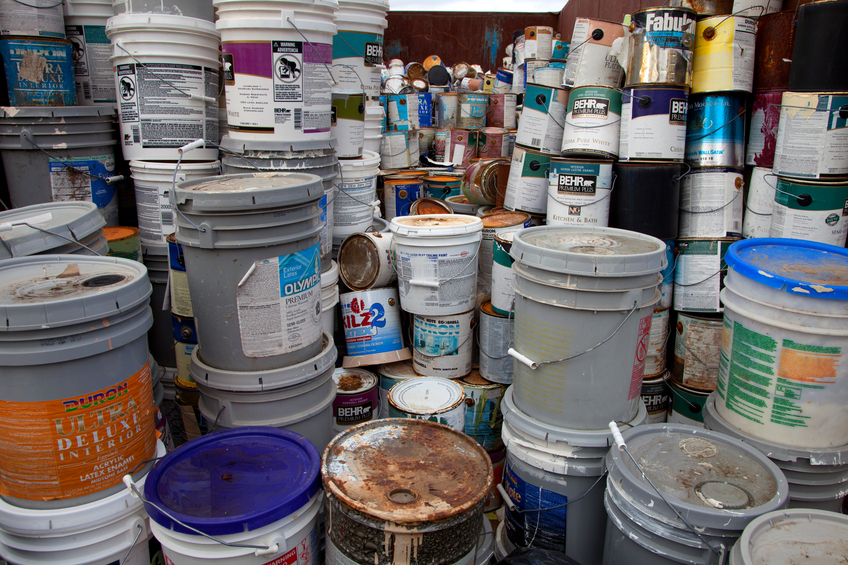If you are an environment, health, and safety (EHS) manager in any number of industries, you likely face the ongoing task of dealing with solvents in your workplace. Today we will do a quick review for determining if your used solvents are hazardous waste, and tomorrow we will offer tips for protecting your workers from exposure to solvents.
 |
Note: This article applies to the federal Resource Conservation and Recovery Act (RCRA) rules for solvent wastes. Your state may have stricter hazardous waste management rules and may identify additional solvents that are subject to hazardous waste rules when discarded.
If your used solvents are hazardous waste, you have the onerous and costly task of managing and disposing of them as such. Because of the costs and time associated with managing and disposing of hazardous waste under RCRA, you don’t want to just tag your used solvents as hazardous and not bother with the RCRA processes. On the other hand, because of the penalties that come with RCRA violations, you don’t want to mismanage the solvents either.
So, you need to determine if your used solvents are hazardous waste.
Do You Use Solvents at Your Facility?
A solvent is usually a liquid that is either a single chemical or a mixture of chemicals used to dissolve a substance or material. This property allows solvents to be used as cleaning agents, in chemical manufacturing, or as ingredients in other products. There are any number of industries that have used solvents and include but are not limited to:
- Adhesive manufacturing
- Auto manufacturing and repair
- Electronics manufacturing
- Dry cleaning
- Furniture manufacturing
- Metal finishing and plating
- Paint manufacturing and use
- Pulp and paper manufacturing
- Wood staining and varnishing
If your facility is involved in industrial cleaning and degreasing, it’s a sure bet that you are using solvents.
Is Your Solvent a Solid Waste?
In order to figure out if your solvents are hazardous waste, you first have to determine if they are a solid waste. Things to consider are:
- Is the solvent “spent,” meaning is it contaminated and no longer can be used for its intended purpose unless it is somehow reprocessed?
- Is it expired?
- Is it an off-specification commercial chemical product and can no longer be used?
- Is it unwanted and/or unused and destined for disposal?
- Is it a residue, contaminated soil or water, or debris from the cleanup of a solvent spill?
If the answer is “yes” to any of these questions, your solvent is a solid waste.
Is Your Solvent a Hazardous Waste?
As soon as you have figured that your solvent is a solid waste, you must determine if it is a hazardous waste. There are two considerations here: whether the solvent is a listed hazardous waste or a characteristic hazardous waste.
Is Your Solvent on a List?
Under RCRA, there are four lists of hazardous waste, three of which (F list, P list, and U list) are found at 40 CFR 261, subpart D. The fourth list (K list) is found at 40 CFR 261.32. Listed solvents are generally found on either:
- The F list—spent solvents from nonspecific sources. The F list includes approximately 30 solvents.
- The P and/or U lists—unused but discarded commercial chemical product solvents. The chemicals on the P list are identified as acute hazardous wastes. Those on the U list are toxic hazardous wastes unless otherwise designated.
What Are Your Solvent’s Characteristics?
Even if you have already determined that your solvent is a hazardous waste because it is on the F, P, or U list, you should figure out whether it is also a characteristic waste because the solvent listing may not address all the constituents of your solvent. This is particularly true for F-listed, spent solvents that have been contaminated through use with other materials, such as dirt or grease that could contain heavy metals.
And, if your solvent is not a listed hazardous waste, you should determine if it is a characteristic waste.
A RCRA characteristic hazardous waste will exhibit at least one of four characteristics:
- Ignitability—the waste can create fires under certain conditions, are spontaneously combustible, or have a flash point less than 140º F.
- Corrosivity—the waste is a water-based acid or base with a ph less than or equal to 2, or greater than or equal to 12.5; and/or a liquid that can corrode steel.
- Reactivity—the waste is normally unstable and readily undergoes violent change without detonating, such as wastes that react explosively with water.
- Toxicity—the waste is harmful or fatal if ingested or absorbed.
Determining whether a waste is hazardous is an art and science unto itself. This article is a quick primer. For a wealth of compliance tips, guidance documents, and training tools for all your hazardous waste management needs, be sure to check Enviro.BLR.com®.

This is really helpful to me as I am working for API Bulk Drug Company.